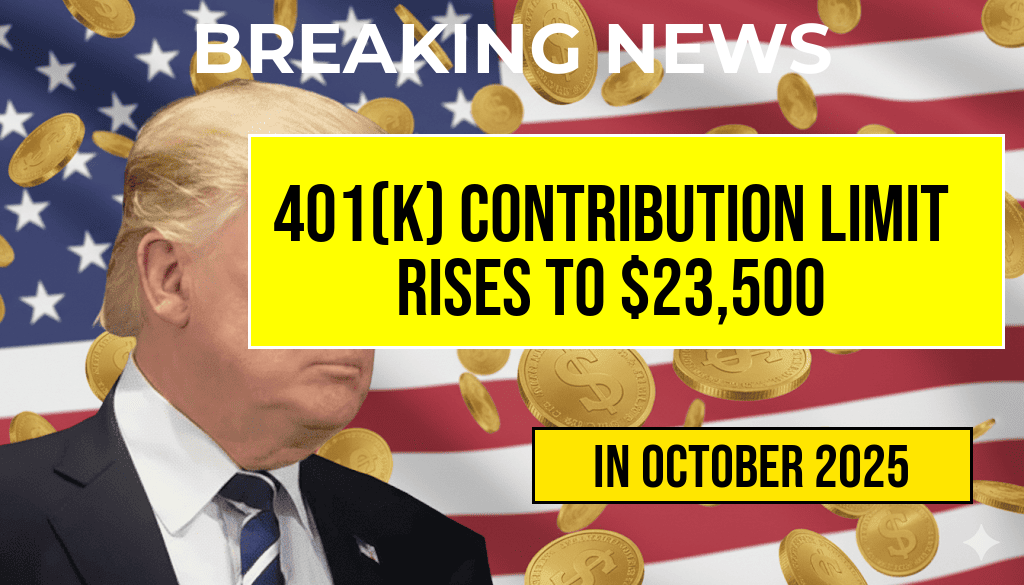Starting in 2025, employees will be able to contribute up to $23,500 to their 401(k) retirement plans, a notable increase from the previous limit of $22,500. This adjustment, announced by the Internal Revenue Service (IRS), is part of an annual cost-of-living adjustment aimed at helping workers save more for retirement amid rising inflation and increasing living costs. The increase reflects ongoing efforts to enhance retirement security for American workers and aligns with the IRS’s commitment to adjusting contribution limits based on inflation rates. With this significant rise, employees are encouraged to reassess their retirement savings strategies to take full advantage of the increased limits.
Understanding the Increase in Contribution Limits
The 401(k) contribution limit is subject to change based on inflation, reflecting economic conditions and the purchasing power of the dollar. The increase to $23,500 marks the largest annual jump in recent years and aims to provide workers with greater opportunities to build their retirement nest eggs. This adjustment is not only beneficial for individual savers but also aligns with broader economic trends that emphasize the importance of financial preparedness for retirement.
Impact on Retirement Savings
For many employees, the increased limit allows for a more aggressive savings strategy, particularly for those who may be behind in their retirement planning. The additional $1,000 can significantly enhance the total savings over time, especially when considering the benefits of compound interest. Here’s how the increase can impact an individual’s retirement savings:
- Increased Savings Potential: Contributing the maximum amount allows employees to accumulate more funds for retirement, potentially leading to a more comfortable lifestyle post-retirement.
- Tax Advantages: Contributions to a 401(k) are typically made pre-tax, which can lower an individual’s taxable income for the year, providing significant tax benefits.
- Employer Matching: Employees who maximize their contributions may also benefit from employer matching programs, further boosting their retirement savings.
Retirement Planning Strategies
As the contribution limit increases, employees should consider revisiting their retirement planning strategies. Here are some recommended approaches to make the most of the new limits:
- Evaluate Current Contributions: Assess how much you are currently contributing and consider increasing your contributions to the new limit if financially feasible.
- Utilize Catch-Up Contributions: For those aged 50 and older, the catch-up contribution limit remains unchanged at $7,500, allowing for a total contribution of $31,000 in 2025.
- Diversify Investment Choices: Review the investment options within your 401(k) plan to ensure a diversified portfolio that aligns with your risk tolerance and retirement goals.
Looking Ahead: Future Trends in Retirement Savings
The increase in 401(k) contribution limits reflects a broader trend towards enhancing retirement security in the U.S. As the cost of living continues to rise, it is expected that future adjustments will also focus on providing workers with more opportunities to save for their retirement. Financial experts often recommend staying informed about policy changes and market conditions that could impact retirement savings.
For more information on retirement savings and planning, resources from the IRS and Forbes provide valuable insights into maximizing your retirement contributions and understanding the implications of these changes.
Conclusion
The IRS’s announcement of the increased contribution limit to $23,500 for 401(k) plans in 2025 is a significant development for American workers. This change encourages proactive retirement planning and highlights the importance of adapting savings strategies to meet evolving economic conditions.
Frequently Asked Questions
What is the new contribution limit for 401(k) plans in 2025?
In 2025, employees can contribute up to $23,500 to their 401(k) plans, which marks a significant increase from previous years.
How does the 2025 contribution limit compare to previous years?
The 2025 contribution limit of $23,500 represents a notable increase over prior limits, allowing employees to save more for retirement.
Who is eligible to contribute to a 401(k) plan?
Generally, any employee who works for a company that offers a 401(k) plan is eligible to contribute, subject to specific plan rules and regulations.
Can employees contribute more than the limit if they are over 50?
Yes, employees aged 50 and older can make catch-up contributions, allowing them to contribute beyond the $23,500 limit to help boost their retirement savings.
What are the benefits of contributing to a 401(k) plan?
Contributing to a 401(k) plan offers several benefits, including tax advantages, employer matching contributions, and the opportunity to grow retirement savings through investments.

Leave a Reply